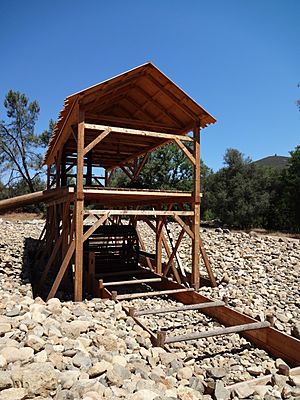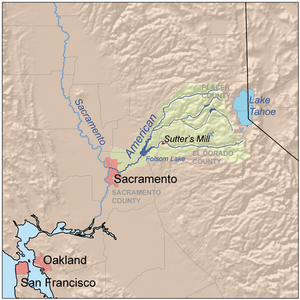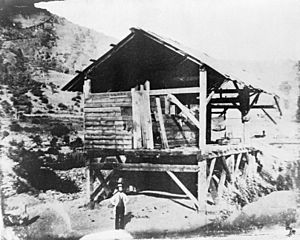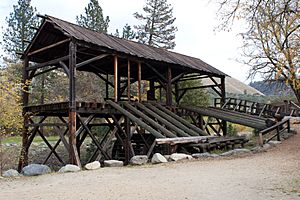Sutter's Mill facts for kids
Quick facts for kids Sutter's Mill |
|
|---|---|

2014 replica of Sutter's Mill
|
|

Location of Sutter's Mill
|
|
| Location | Coloma, California |
| Area | Marshall Gold Discovery State Historic Park |
| Governing body | California Department of Parks and Recreation |
| Official name: Gold discovery site | |
| Designated | March 7, 1955 |
| Reference no. | 530 |
Sutter's Mill was a special kind of factory that used water power to cut wood. It was located next to the South Fork American River in the beautiful Sierra Nevada mountains of California. The mill was named after its owner, John Sutter.
In 1848, a worker named James W. Marshall found gold at the mill. This amazing discovery started the famous California gold rush (1848–1855). The gold rush was a huge event in the history of the United States.
Today, a replica of Sutter's Mill stands in the same area. It is part of the Marshall Gold Discovery State Historic Park in Coloma, California. Also, a meteorite fell near the mill in 2012. Its pieces are now called the Sutter's Mill meteorite.
Contents
The Story of Sutter's Mill
The land that is now California was once called Alta California. It was settled by Spain starting in 1683. Later, in 1821, it became part of independent Mexico.
John Sutter, who was from Germany and Switzerland, arrived in this region in 1839. He started a settlement called New Helvetia. This area is now part of Sacramento.
The United States took control of California during the Mexican–American War (1846–1848). A peace agreement for the region was made in January 1847. Even before the main war ended, John Sutter decided to build a sawmill. It was about 30 miles northeast of his settlement. Sutter hired James W. Marshall, a carpenter, to manage the building of the new mill.
The Discovery of Gold
On January 24, 1848, while working on the mill, Marshall saw shiny flakes in the South Fork American River. It was gold! Just a few days later, on February 2, 1848, a peace treaty was signed in Mexico City. This treaty officially gave California to the United States.
Two workers at the mill, Henry Bigler and Azariah Smith, kept journals. Bigler wrote down the exact date gold was found: January 24, 1848. John Sutter told the U.S. government about the gold. An official named Joseph Libbey Folsom confirmed the discovery in June.
The very first piece of gold Marshall found was sent to President James K. Polk in Washington D.C. It arrived in August 1848. You can see it today at the National Museum of American History. This museum is part of the Smithsonian Institution.
The California Gold Rush Begins
As news of the gold spread, many people rushed to California. The number of non-native people in California grew from 14,000 in 1848 to 224,000 by 1852. Over 80,000 new people arrived in 1849 alone.
Many of these newcomers settled in a new town called Coloma, California. This town grew up very close to Sutter's Mill. More gold was found in other places across California.
Over the next seven years, about 300,000 people came to California. Half traveled by land, and half came by sea. They hoped to find gold or sell supplies to the gold seekers. This California gold rush changed California forever. It brought many new people and boosted the economy. California officially became a U.S. state in 1850.
Sutter's Mill Today
The place where Sutter's Mill once stood is now part of the Marshall Gold Discovery State Historic Park. It is recognized as California Historical Landmark number 530.
In 1965, work began to build a copy of the original mill. This replica was based on Marshall's own drawings and an old photograph from around 1850. The replica was finished in 1966 and officially opened on January 21, 1968. It was designed to be moved to the exact original spot if the river changed back to its 1848 path.
In 2014, the 1960s replica was replaced with an even newer one. This latest replica was built closer to where the first mill actually stood.
The Sutter's Mill Meteorite
On April 22, 2012, a meteor entered Earth's atmosphere. It exploded high above, sending pieces of meteorite falling over parts of California and Nevada. The first pieces of this space rock were found near Sutter's Mill. Because of this, the meteorite was named the Sutter's Mill meteorite.
Scientists found many pieces, weighing about one kilogram (2.2 pounds) in total. This meteorite is a special type called a carbonaceous chondrite. It contains some of the oldest materials ever found in our Solar System!
Want to Learn More?
See also
 In Spanish: Sutter's Mill para niños
In Spanish: Sutter's Mill para niños



